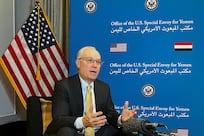ABU DHABI // The emirate's urban master plan, Abu Dhabi 2030, has drawn criticism from planners here and abroad for splitting the city into districts. Designed by a team led by the Canadian urban planner Larry Beasley, the plan encompasses public transit, residential and commercial development, environmental measures and growth limits.
It would create five districts: Capital, Corniche, Grand Mosque, the Lulu Island special district and the Saadiyat Island cultural district. Designers and proponents of the plan say districting would disperse the concentration of residents and offices, ease traffic congestion with more roads and public transit, and mean that people would not need to travel far between home, work, school and amenities.
But critics say it would create isolated pockets of social and civic activity and promote vehicle use because of the distance between districts. Adrian Hornsby, the UK-based writer and urban theorist, said the dynamic experience of a city came from being able to use space spontaneously. Mr Hornsby used the analogy of goods in a store being arranged so the customer is exposed to as much of them as possible. His concern was that the plan risked creating a series of disconnected pods.
"Carving up cities into ultra-specific use zones precludes the possibility of people going into a zone and thus being exposed to it unless they deliberately chose to," Mr Hornsby said. "This is the danger of the Abu Dhabi 2030 Plan, where in particular the cultural area on Saadiyat Island risks becoming an isolated tourist destination, with no relationship to the rest of the city or the people living there."
Richard Wagner, a Dubai-based architect and the deputy president of the UAE Architectural Association, said the development in Dubai had favoured the suburban model, with separate areas such as Media City, Academic City and Health Care City, which he said contributed to the enormous traffic problem. "It's an easier way of planning, rather than the more complicated approach of having to account for what will happen in the future of a city," Mr Wagner said. "But it makes traffic worse and it requires a lot of infrastructure."
George Katodrytis, a professor of architecture at the American University of Sharjah, said he liked the Canadian city of Toronto, where a liberal approach to different districts had resulted in a diverse urban landscape. With its fashion, music and industrial areas mixed with residential development, Mr Katodrytis said Toronto had one of the most vibrant streetscapes he had seen. And unlike a city such as Dubai, he said the people of Toronto identify with the entire city, because each neighbourhood or district is connected to another and accessible without vehicles.
Falah al Ahbabi, the general manager of the Urban Planning Council, said much of the criticism of the 2030 Plan came from misunderstanding it. "These aren't discrete districts. We are creating living neighbourhoods and we will provide for everything within them - residences, education, workspaces, as well as parks," Mr al Ahbabi said. Planning ideas and models that apply to North American and European cities do not necessarily apply to the UAE, he said.
For example, Mr al Ahbabi said, many cities do not want development to spread out because natural areas have to be preserved, but beyond the city is the desert. He said that within the city, measures had been taken to preserve sensitive environments such as the mangrove forests along the coast. But the city's rapid population growth had to be provided for, and without precious old-growth forests surrounding it, Abu Dhabi could expand the city limits without diminishing its ecological integrity.
Mr Beasley said no plan had encompassed as many elements of urbanism as Abu Dhabi's. He said people had misunderstood the 2030 Plan by looking at maps without reading the attached policies. "We're creating districts, yes, but you have to look at the policies behind them. These are dense, mixed use areas connected by public transit," he said. Mr Beasley said Dubai left much to be desired with its random development and specialised districts accessible only by cars along congested roads.
But he said the districts in the 2030 Plan were nothing like Dubai's. "These areas are diverse, walkable and they're places where people can live, work and send their kids to school. I can't really think of anything more urban than that." @Email:jhume@thenational.ae





